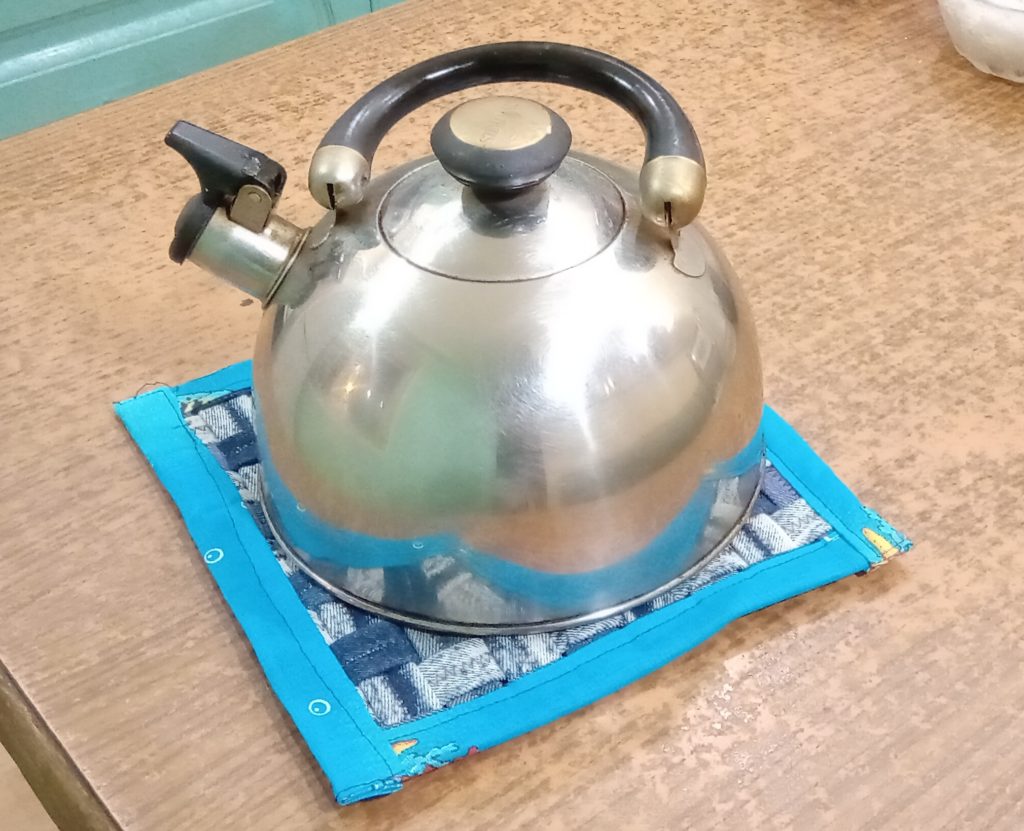Craftswomen can make many useful things from old jeans: shorts, skirts, jewelry, household items. Even small pieces of material that remain after major “alterations” can be used.
How to sew a coaster from small denim strips
This thing is useful for placing a boiling kettle, pan or baking sheet from the oven on it. Denim is the optimal material for such a product because it:
- does not melt under high temperature;
- thick enough to protect the table cover or other work surface from contact with hot dishes.
Tools and materials
So, for work you will need:
- denim scraps;
- strips of other fabric (for finishing edges);
- sewing machine;
- scissors, needles, threads;
- ruler or centimeter;
- a pen, a thin piece of soap (if the material is completely dark);
- ironing board, iron.
Important! All materials for work - fabrics and threads - must be natural, without synthetic impurities. Otherwise, as a result of operation, the product may become deformed and become unusable.
Preparing parts
First, we put the pieces of fabric in order: they need to be washed and ironed. Then we make markings on the denim. The process will take less time if you make a rectangular stencil. There are no strict requirements for its size, but it is better that its length be at least 20 cm. If you make it smaller, the area of the bottom of the dish may be larger than the area of the stand. We apply it to the denim fabric, trace and cut out the required number of blanks.
The number of parts is calculated by the formula:
L ÷ (s ÷ 2) * 2, where L is the length, s is the width of the rectangle.
My parts turned out to be 22*4 cm in size. According to the formula, there should be 22 of them, but I got by with 20 (I’ll explain why later).

@textile-en.techinfus.com
The next step is processing rectangular blanks:
- Place each face down on the ironing board;
- we bend the sides along the entire length so that the edges are connected (for convenience, you can mark the center with a line, dividing the rectangle in half parallel to the long side);
- steam;
- sew on a machine using a wide zigzag.

@textile-en.techinfus.com
Assembly
We lay one strip vertically, and lay the others horizontally along its entire length. In this case, the horizontal denim stripes alternate evenly: one above the vertical, the other below it. For clarity, all the dark ones are on top, the light ones are on the bottom. When everything is settled on the table and in your head, we attach all the strips in this form to the first one.

@textile-en.techinfus.com
Next, we bend the light strips through one (those sewn on the bottom), put a new one across it, and close it. Then everything is repeated with others - dark ones, then again with light ones - and so on until the right edge.

@textile-en.techinfus.com
Having reached the end, you must:
- fasten the structure with pins in several places so that everything does not “move apart”;
- Sew around the perimeter with a straight machine stitch.
It took me 11 strips horizontally, but only 9 vertically, because due to the bends they do not fit tightly together.

@textile-en.techinfus.com
Edge processing
To do this, we will use any suitable material, for example, chintz:
- cut out rectangles of the required length;
- fold in half lengthwise;
- We cover the cuts with them and sew along the perimeter.

@textile-en.techinfus.com
Now you can use the soft denim stand - thanks to it, the table surface will not be damaged.

@textile-en.techinfus.com
If you have the time and desire, you can make a small denim rug using the same technique as for the coaster. It’s just that the denim stripes will be longer and possibly wider. Invent, create, create comfort in your home by turning old, unnecessary jeans into useful household items.
You can watch the video on this article Here.


 0
0





